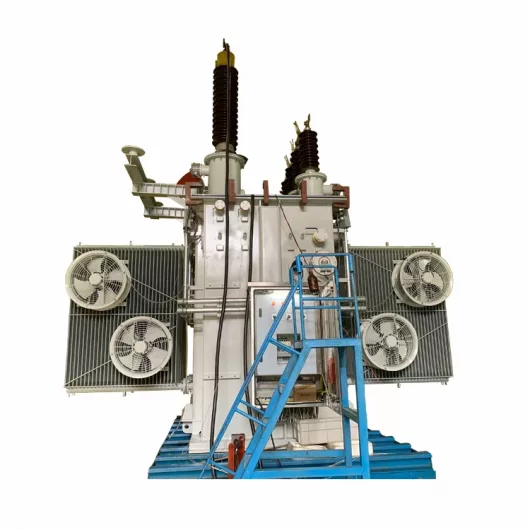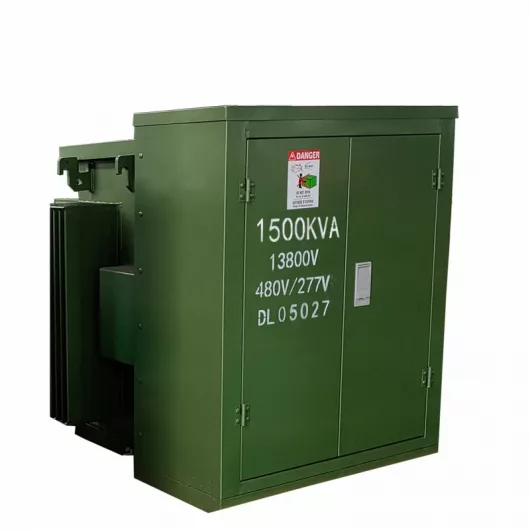ELECTRIC, WITH AN EDGE
In order to meet the reliability and economy of power supply safety of chemical production equipment, the power system is in the design work of expansion and construction of substations.
The first consideration is to select the number and capacity of transformers according to the reliability of the power supply load of the substation and the nature of the power supply.
If the selected transformer capacity is too large, it will inevitably increase the investment in related equipment and the investment in the transformer itself, resulting in unnecessary design waste.
For example, the investment in the purchase and installation of transformers, operation and maintenance of transformers;
If the selected transformer capacity is too small, it will inevitably not be able to meet the normal demand for power supply.
If the transformer is kept in overload operation for a long time, it will easily cause damage to the transformer, which will have a major impact on the safety and reliability of the power supply;
The number of selected transformers is too small, and the wiring method and power supply reliability will not meet the requirements, which will inevitably affect the maintenance and lack of necessary backup transformers;
Too many selections of the number of transformers will increase the investment in supporting facilities, make the layout of the substation difficult, and increase the workload of overhaul and maintenance.
Therefore, if the transformer capacity and quantity are selected appropriately, not only can it save a lot of one-time investment in construction, but also reduce the corresponding operation and maintenance costs because of the reasonable operation of the transformer.
This article will combine actual design experience and practical problems to describe the principles that should be followed when selecting the number and capacity of transformers, as well as the various requirements and conditions for the reliable and safe operation of the transformer itself.
Comprehensive consideration of the comprehensive factors that need to be considered when selecting the number and capacity of transformers, and then conduct a comprehensive benefit and safety analysis of the number and capacity of transformers and a load of power supply.

The main factors affecting the reliability and economy of power supply safety are the capacity and number of transformers. In addition, it is also the main factor affecting the grid structure.
The initial selection of the capacity and number of transformers is often determined by the current load status and growth expectations, and at the same time depends on the following factors:
How much one-time construction investment;
The ability of the surrounding upper-level power grid or power plant to provide load;
The load itself requires the safety and reliability of power supply and the nature of the load itself;
The cost per unit capacity of the transformer itself, and the short-circuit capacity of the power system;
The conditions for the installation and operation of the transformer itself;
Technical and performance indicators of the power distribution device connected to the transformer.
In recent years, with the continuous improvement of transformer manufacturing technology, the quality of transformer itself and the level of safe operation have been greatly improved;
The no-load loss rate of the transformer has been greatly reduced, and the load rate of the economic operation of the transformer has been continuously reduced;
10+FAQ ABOUT THE MAIN POWER TRANSFORMER
Generally based on design experience and combined with relevant specifications, the author believes that the relevant factors that need to be fully considered are as follows:
(1) The rated capacity of the transformer must meet the needs of safe and reliable power supply of all electrical loads in all power supply areas, so as to avoid the transformer from being in a long-term overload state.
The choice of transformer capacity for new substations also needs to meet the development of the enterprise, and then consider the growth needs of electricity load.
In this way, it can avoid unnecessary capacity expansion and expansion when the power load increases in the later period, and also reduce the long-term power outage of the production equipment caused by the expansion and capacity expansion;
For substations with high power supply safety and reliability requirements, two transformers need to be put in at a time, and the normal load rate of each transformer should preferably not be greater than 50% of its rated power.
(2) For the transformation and distribution substations of production equipment with higher power load levels, it is necessary to consider when one of the transformers is out of power for maintenance or when it is out of order.
The other transformer should be able to meet the requirements of normal power supply for the primary load and secondary load of the whole plant within the time allowed by the overload capacity.
For a general substation, when one of all the transformers is out of service, the other transformers must have the ability to guarantee the power supply of 70% to 80% of the total load.
(3) In order to meet the reliability and flexibility requirements of the substation’s own operation mode, at the same time reduce and facilitate the reservation of spare capacity, meet the requirements of convenient inspection and maintenance, and then meet the requirements of the unified specification of the substation.
Therefore, when choosing the transformer capacity and type, it should be reduced as much as possible. Basically, there should be no more than two types.
And it is better to choose a transformer of the same capacity level in a substation that supplies power to the device.
(4) Within a certain capacity range, an increase in capacity will reduce the loss of the transformer, but the saved electricity may be difficult to compensate for the increase in initial investment costs.
Because of the high breaking capacity requirements of the matching switches and other equipment, the one-time investment in related devices should also be considered when selecting the transformer capacity.
(1) The phased construction of new substations needs to consider load growth. When there is only one transformer in operation in the early stage, the transformer capacity should be determined based on the final scale of the entire plant. When the transformer in the best economic operation area is in operation, it is less than 75%. However, if the substation cannot be expanded for a short period of time, the transformer should not be operated at full load for a long time.
(2) If multiple power transformers are required to operate in parallel, the parallel connection conditions need to be standardized, and the phase relationship and connection group of each transformer must be the same;
The transformation ratio and voltage of each transformer must be the same, and at the same time the degree of deviation of the operation must be the same, and the voltage of each level is the same within the voltage regulation range;
It is necessary to prevent circulating current due to the electromotive force difference between the secondary windings, which affects the capacity output or even burns the transformer;
The short-circuit impedance also needs to be kept the same as much as possible, and if it is different, it must be controlled within 10%;
The capacity ratio is between 0.5 and 2, so that the entire load can be evenly distributed;
The transformer with the smaller capacity is in an overload state, while the transformer with the larger short-circuit impedance and the larger capacity is under-load, the size of the short-circuit impedance must meet the requirements of the short-circuit current of the system, otherwise restrictive measures should be taken.
(3) For transformers that operate under normal conditions, the temperature of each insulating component and oil should not be too high. Try to control the temperature within the temperature limit specified in the transformer load guideline, and try not to run the transformer at high temperatures to avoid The shortening of the service life of the transformer and the damage of the transformer caused by the aging and acceleration of the insulation. It is also necessary to prevent excessive loss of the transformer itself when the transformer is running at an excessively high temperature, which will affect the output efficiency of the transformer and cause waste of electric energy.
(4) If a backup power transformer is installed in the substation, a transformer with a small comprehensive power loss (including the cooling power of the transformer) should be selected for operation, and the best combined operation mode should be selected according to the law of load changes to increase the load rate and load The power factor, so that the transformer is in the best economic operation area.
(5) The average load factor of the economic operation area of a single power transformer is β, the upper limit of β is 1, and the lower limit is the no-load loss of the power transformer / the rated loss of the power transformer, the average load of the optimal section in the best economic operation area For the coefficient, the upper limit of β is 0.75, and the lower limit is 1.33.
(6) The economic operation of transformers can only be considered when the preconditions of safe and reliable power supply are met. The backup transformer should have an automatic switching device, and the device should be safe and reliable, so as to ensure that the main power supply transformer It can be put into operation automatically in case of failure to ensure the continuation of normal power supply.
(7) For transformers operating in parallel operation mode, the rated breaking capacity of the tie switch must be accurately calculated to prevent the fault point caused by insufficient rated breaking capacity of the switch from being automatically isolated during short-circuit faults.
Four, design examples
A chemical group production base. It covers an area of 50,000 square meters, with a plant building area of 80,000 square meters. According to the electricity load per unit area of the chemical industry, the unit electricity load statistical calculation method is adopted; the electricity load per square meter is taken as 50kVA, the total calculated electricity consumption of the factory is 40MVA, but the actual production and office electricity consumption is less than this calculation, so In the actual construction, the unit number method and the need coefficient method are combined, and the actual power consumption of the plant is determined to be 0.8x40MVA=32MVA, which is more accurate. Finally, 3 high-voltage substations were set up in the factory area, each with a capacity of 12000kVA and 6 sets of 2000kVA transformers. The actual operating transformer load rate is 85%.
The selection relationship between the electrical load of chemical production equipment and the capacity and number of power transformers will have an impact on the economic and safe operation of the production equipment and will affect the efficiency of the industry and the safety and comprehensiveness of the system.
Therefore, the selection of the transformer must be based on the inherent properties of the power transformer, and then a more comprehensive analysis and calculation must be carried out, and the load development plan of the chemical plant must be considered comprehensively. Take into account the nature of electricity consumption and the requirements for reliability, and coordinate the comprehensive factors of the whole plant’s load. Give full play to the best economic operation and energy-saving indicators of transformers, so as to achieve the unification and optimization of the capacity and number of transformers for the whole plant load, and realize the safety of enterprise power supply and maximize the economic benefits.
When you need to find more than just existing transformers, Daelim’s Transformer Service Center can help you design and produce distribution transformers that meet your unique needs.
We have our own factory and a professional team of engineers, which can design and modify application requirements that meet all your conditions.
Download Resource
ELECTRIC, WITH AN ENGE-- DAELIM BELEFIC



